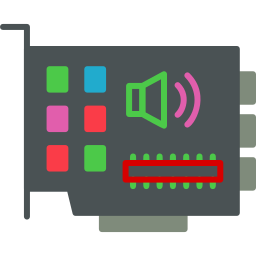
Sound Card – A Key Component for Audio Processing in Computers
A Sound Card is a hardware component responsible for managing audio input and output on a computer. It processes digital audio signals and converts them into analog signals that can be heard through speakers or headphones, and also performs the reverse process for audio input devices like microphones. Sound cards are either integrated into the motherboard or installed as separate internal or external components. Their role is essential for delivering high-quality audio for entertainment, communication, and professional applications.
Main Functions and Applications of a Sound Card
Converts digital audio data from the computer into analog signals that can be played through audio output devices such as speakers, headphones, or home theater systems.
Captures analog signals from microphones and other audio input devices and converts them into digital data that the computer can store, transmit, or process.
Enhances the overall audio experience by supporting surround sound, noise reduction, equalization, and various sound effects.
Supports various audio formats and sample rates, allowing playback of music, sound effects, and voice with high fidelity.
Provides multiple input and output ports, including line-in, line-out, mic-in, headphone jacks, and sometimes digital optical ports.
Enables professional audio production, including music composition, podcast recording, voiceovers, and sound editing.
Improves in-game sound quality and realism, providing immersive audio effects in gaming environments.
Supports real-time voice communication in applications such as video conferencing, online gaming, and broadcasting.
Allows for the use of specialized audio hardware, such as studio monitors, external DACs (Digital-to-Analog Converters), and high-impedance headphones.
Types of Sound Cards
Integrated Sound Cards: Built into the motherboard of most computers and laptops. They offer basic audio capabilities suitable for everyday tasks such as watching videos, listening to music, or participating in online meetings.
Dedicated/Internal Sound Cards: Installed in a PCI or PCIe slot on the motherboard. These provide superior audio quality and more features than integrated sound cards. They are preferred by gamers, audio professionals, and audiophiles.
External USB Sound Cards: Portable sound solutions that connect to the computer via USB ports. Ideal for laptops or systems without upgrade options. These can offer professional-level audio quality and flexibility.
Cost and Accessibility
Integrated sound cards come at no additional cost, as they are included with most motherboards. These are generally sufficient for casual users and standard media playback.
Dedicated sound cards must be purchased separately. Their cost varies depending on the brand, features, and performance levels. Entry-level models are affordable, while professional-grade cards designed for studio work or advanced gaming setups can be significantly more expensive.
External sound cards also require a separate purchase, and prices vary based on audio quality, input/output options, and additional features.
The use of a sound card itself does not involve any ongoing or subscription-based fees. However, professional audio software and plugins that rely on advanced sound card capabilities may involve additional costs.
Comparison with Other Hardware Components
Sound Card vs. Graphics Card: A sound card handles audio processing, while a graphics card manages video and visual rendering. Both are essential for multimedia performance but serve entirely different functions.
Sound Card vs. Capture Card: A sound card processes sound input and output, while a capture card records external audio and video sources. Capture cards may work with a sound card for recording and streaming setups but are used for different tasks.
Sound Card vs. DAC (Digital-to-Analog Converter): A sound card includes a DAC as part of its circuitry, but external DACs can be used separately for even higher audio fidelity. Some audiophiles and professionals use standalone DACs with or without a dedicated sound card.
Sound Card vs. Audio Interface: Audio interfaces are specialized devices used mainly in professional audio production. While they function similarly to external sound cards, they offer higher quality preamps, more input/output options, and are optimized for studio use.
Conclusion
The Sound Card is a fundamental hardware component that significantly affects a computer’s ability to produce and process audio. Whether integrated or dedicated, it allows users to experience sound in a clear, detailed, and immersive manner. While basic sound functionality is typically free and included with most systems, advanced users may invest in higher-end sound cards for enhanced audio performance. In professional, gaming, or content creation environments, having a capable sound card can make a noticeable difference in audio quality and system responsiveness. Understanding the different types and their applications helps users choose the right sound solution based on their needs.












